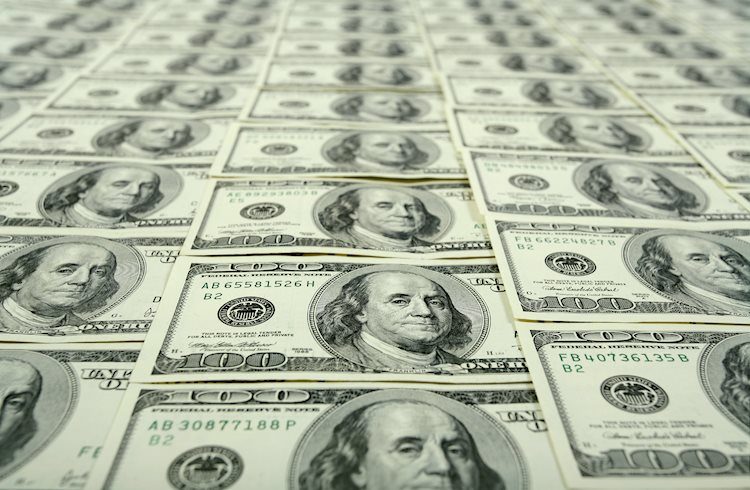Investors are focusing on Fed Chair Powell’s hawkish stance and US Treasury yields at multi-month highs.
The Fed’s Beige books, set to be released later in the session, will be closely watched.
The US Dollar Index (DXY) stands at 106.10, showing mild gains. The shift in the index’s trend appears influenced by several factors including strong growth and persistent inflation in the US, as well as increased hawkishness from Federal Reserve (Fed) officials.
The US economy is seeing sticky inflation and robust growth. Fed Chair Powell’s hawkish stance shows that instead of another rate hike, the Fed favors market tightening through higher yields and wider spreads, which strengthens the USD. However, with financial conditions still loose, further tightening is required and Powell commented on Tuesday that the monetary policy may need additional time to work.
Federal Reserve Chair Powell was seen hawkish on Tuesday and warned that there is little progress on inflation. He also stated that the bank remains data-dependent.
The possibility of a rate cut in the next meeting in June stands at around 15%, a huge drop compared to the previous week’s 60%. Also, the chances for a July rate cut have fallen below 50%.
The first-rate cut is expected to take place in September with a 95% probability, followed by another in December at a 70% probability.
The US Treasury yields for the 2-year, 5-year and 10-year Treasury bonds are currently standing at 4.93%, 4.63% and 4.61%, respectively, down on the day. Despite the recent decrease, the 2-year and 10-year yields are at their highest since November.
On the daily chart, the Relative Strength Index (RSI) continues exhibiting overbought conditions, hinting at an upcoming correction or consolidation phase. The Moving Average Convergence Divergence (MACD) shows decreasing green bars, implying that the buying momentum is losing steam and that the bears may soon take charge.
However, the pair is comfortably positioned above its 20, 100 and 200-day Simple Moving Averages (SMAs), indicating the bulls’ dominance in the current scenario. This suggests a positive medium to long-term outlook, with the bulls defending their ground despite the technical indicators pointing toward a short-term bearish influence.
The US Dollar (USD) is the official currency of the United States of America, and the ‘de facto’ currency of a significant number of other countries where it is found in circulation alongside local notes. It is the most heavily traded currency in the world, accounting for over 88% of all global foreign exchange turnover, or an average of $6.6 trillion in transactions per day, according to data from 2022. Following the second world war, the USD took over from the British Pound as the world’s reserve currency. For most of its history, the US Dollar was backed by Gold, until the Bretton Woods Agreement in 1971 when the Gold Standard went away.
The most important single factor impacting on the value of the US Dollar is monetary policy, which is shaped by the Federal Reserve (Fed). The Fed has two mandates: to achieve price stability (control inflation) and foster full employment. Its primary tool to achieve these two goals is by adjusting interest rates. When prices are rising too quickly and inflation is above the Fed’s 2% target, the Fed will raise rates, which helps the USD value. When inflation falls below 2% or the Unemployment Rate is too high, the Fed may lower interest rates, which weighs on the Greenback.
In extreme situations, the Federal Reserve can also print more Dollars and enact quantitative easing (QE). QE is the process by which the Fed substantially increases the flow of credit in a stuck financial system. It is a non-standard policy measure used when credit has dried up because banks will not lend to each other (out of the fear of counterparty default). It is a last resort when simply lowering interest rates is unlikely to achieve the necessary result. It was the Fed’s weapon of choice to combat the credit crunch that occurred during the Great Financial Crisis in 2008. It involves the Fed printing more Dollars and using them to buy US government bonds predominantly from financial institutions. QE usually leads to a weaker US Dollar.
Quantitative tightening (QT) is the reverse process whereby the Federal Reserve stops buying bonds from financial institutions and does not reinvest the principal from the bonds it holds maturing in new purchases. It is usually positive for the US Dollar.
Share:
Feed news
Information on these pages contains forward-looking statements that involve risks and uncertainties. Markets and instruments profiled on this page are for informational purposes only and should not in any way come across as a recommendation to buy or sell in these assets. You should do your own thorough research before making any investment decisions. FXStreet does not in any way guarantee that this information is free from mistakes, errors, or material misstatements. It also does not guarantee that this information is of a timely nature. Investing in Open Markets involves a great deal of risk, including the loss of all or a portion of your investment, as well as emotional distress. All risks, losses and costs associated with investing, including total loss of principal, are your responsibility. The views and opinions expressed in this article are those of the authors and do not necessarily reflect the official policy or position of FXStreet nor its advertisers. The author will not be held responsible for information that is found at the end of links posted on this page.
If not otherwise explicitly mentioned in the body of the article, at the time of writing, the author has no position in any stock mentioned in this article and no business relationship with any company mentioned. The author has not received compensation for writing this article, other than from FXStreet.
FXStreet and the author do not provide personalized recommendations. The author makes no representations as to the accuracy, completeness, or suitability of this information. FXStreet and the author will not be liable for any errors, omissions or any losses, injuries or damages arising from this information and its display or use. Errors and omissions excepted.
The author and FXStreet are not registered investment advisors and nothing in this article is intended to be investment advice.





